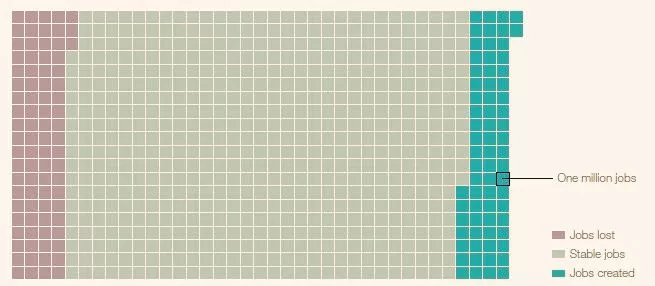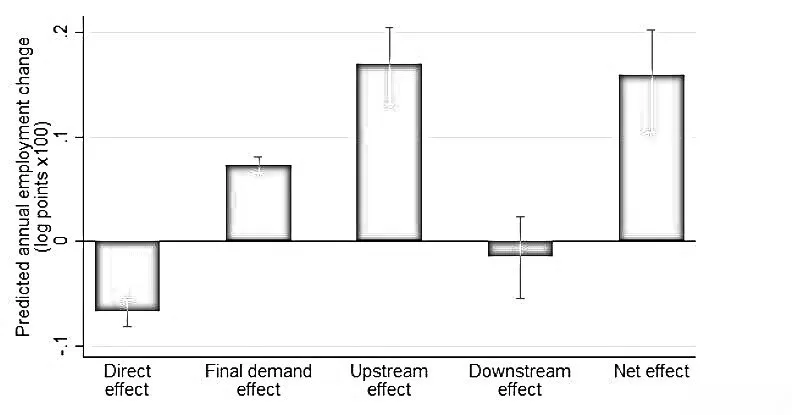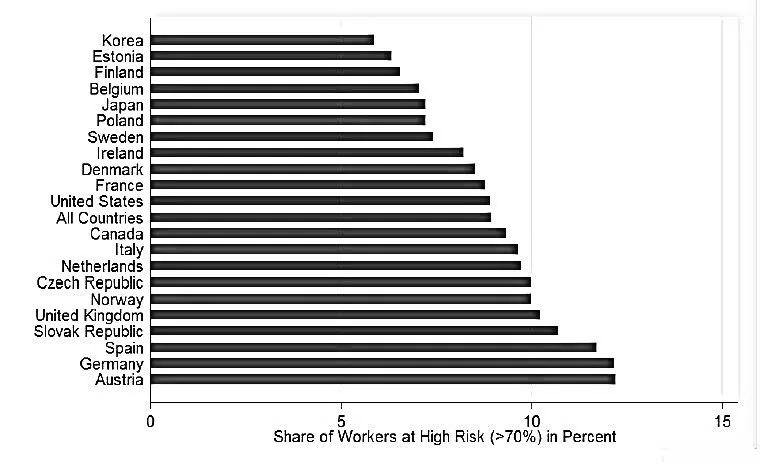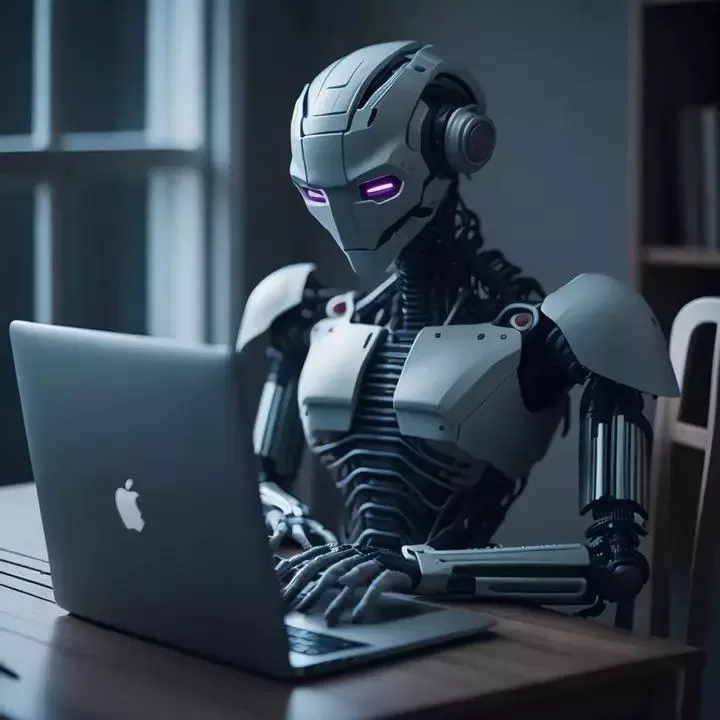The impact of artificial intelligence (AI) is still a mystery. No matter what anyone says, we still don’t know the true impact of AI on jobs and our future. We know that everything from AI voice Assistants like Alexa and Siri to generative AI like ChatGPT are changing the world.
AI is changing how we live, work, and entertain ourselves. But it’s the work part that understandably worries people the most. We don’t know the impact of AI on jobs just yet. So until the future comes, all I can provide you is a well-researched guess.
Exploring the Impact of AI on Jobs
The World Economic Forum’s ‘Future of Jobs Report 2023’ says employers expected AI to replace 83 million jobs globally by 2028. But they also believe that AI will create another 69 million new jobs. So it isn’t all doom and gloom.
Assuming they’re right, AI will displace 14 million jobs or 2% of current employment.

The new jobs AI will create will be different from the ones displaced. Jobs involving mundane tasks like data entry and processing are the most likely to be automated. While blue-collar jobs requiring physical labor like plumbing and electricians are the least likely to be AI automated.
The WEF report even found that agriculture equipment operators will see the highest growth in the next 5 years.
A new wave of employment prospects will emerge due to the impact of AI on jobs. These positions will require soft skills such as empathy, creativity, and problem-solving.
From Luddites to Robots: A Retrospective on Technology’s Effect on Employment
Wharton economist Jeremy Rifkin wrote a bestseller in 1995 titled ‘The End of Work’ where he predicted that robots would automate everything. Vinod Khosla, founder of Sun Microsystems, predicted in 2012 that robots would automate 80% of doctors’ jobs by 2030.
And a 2017 peer-reviewed study from Oxford University claimed that 47% of US jobs were likely to be automated. Are any of these predictions true? I think it’s too soon to tell. The truth is we don’t know yet whether robots can be doctors, replace all jobs, or even half of them.
But what these predictions reveal is the underlying fear behind new technology. We’re worried that technology will replace us.
It could replace some jobs.
It might replace all jobs.
It’ll definitely replace some jobs.
But we don’t know yet.
I believe looking at the past is the greatest way to understand the impact of AI on jobs and our future.
The job market has always been changed by new technology. It has resulted in destroying existing professions and creating new ones. This has been true since before the industrial revolution, and it remains true today.
Automation and Luddites
Wiliam Lee invented the stocking frame knitting machine in 1589. It automated textile work that previously needed many workers. Despite disapproval from Queen Elizabeth, Lee’s machine prevailed.
By the 19th century, textile mechanization was so disruptive it gave birth to violent organized opposition. The riots were known as the Luddite riots. The Luddites were named after a mythical ‘King Ludd’. They broke textile machines in a bid to reverse mechanization. They failed.
The Luddites failed because there’s no way to turn back the clock. Once a new technology is introduced, you can’t un-invent it, even with organized violence.
While the Luddites are gone, we still have their fear of machines. It’s time to break that fear.
Shattering the Myth: Positive Impact of AI on Jobs
Despite Vinod Khosla’s predictions, there are more physicians in the U.S. today than ever before. In fact, there’s even a physician shortage.
Unemployment in the U.S. is at a 54-year low in 2023. Some studies even predict that AI will create more jobs than it automates.
I bet you didn’t expect that the impact of AI on jobs could also be positive.
What you also probably don’t expect is that automation and new technology often increase the demand for workers instead of reducing it. How? I’ll explain.
Myth: When companies adopt automation/robots they no longer need their workers
The Ford Motor Company introduced the world’s first car production assembly in 1913. This is considered the pioneering example of automation in manufacturing. Ford’s car production assembly let them reduce car assembly time from 12 hours per car to only an hour and a half.
Naturally, the Ford company would now need fewer workers, right? Wrong.
Ford had only 450 workers at the start of 1908. This was right before introducing machinery.
Ford expanded to 14,366 workers in 1913.
By 1917 they had 36,411.
That’s a 153% increase in 4 years!
Instead of destroying jobs technology increased the number of jobs by over 30 times within the 5 years between 1908 and 1913. This already impressive increase ballooned by 80 times within a decade.
This phenomenon isn’t limited to a single example.
This sort of positive impact of AI on jobs is more common than you’d expect.
A 2019 paper studied manufacturing firms for 27 years between 1990 and 2016 and discovered that firms that adopted new technology and robots hired more workers than those that didn’t.
They found that adopting robots:
Increased firm output by 20-25% within 4 years
Reduced labor cost share by 5-7% points
Increased net job creation to 10%

Reality: Robot adoption increases employment opportunities
There are two reasons why this happens.
1. Increased production
Firms that automate produce more than firms that don’t automate. And when automated firms produce more output, they expand their factories and offices. As a result, they need more workers.
The increased production scale needs more workers overall, even if the number of workers for a specific job decreases.
Going back to Ford, the car assembly line let them manufacture tens of thousands of cars yearly instead of a few hand-crafted ones. This new production scale meant they needed new offices and factories. These new offices and factories needed to be manned by more people.
They didn’t just hire more personnel for the assembly plants. They also hired thousands more salespeople, business administration, and other roles.
So while fewer workers worked on each car, the number of cars made exploded so much the overall number of workers did too.
2. Decreased competition
Automated companies hire more because they destroy their competitors. Automation reduces the cost of production, lowering the cost of goods and forcing high-cost production firms to shut down.
Ironically, the firms that don’t automate lay off the most workers. That’s because they can’t compete with the firms that automate. As a consequence, they must cut costs and close shops.
There’s another thing to note about the effects of decreased competition. When automated firms reduce prices by producing more, they automatically make consumers wealthier. That’s because they’re now spending less money on automated goods than non-automated ones.
So now they have more money left over to spend elsewhere. This increased disposable income that consumers now have creates new economic opportunities and industries.
Here’s an example
When the internet exploded in popularity in the late 90s and early 2000s, travel agencies went out of business in large numbers because people preferred buying their trips online.
Online travel agencies cost less and are more convenient than in-person ones. So the travel agencies that didn’t adapt to the internet closed down.
This led to thousands of people losing their jobs. Tragic.
But at the same time, thousands of people gained employment as programmers on the new online travel agencies.
Not only that. The extra money saved from people now spending less to get trips was spent on other things. These savings created new economic opportunities that, in turn, created new jobs.
The bottom line is that new technology destroys some jobs and creates new jobs directly or indirectly.
So the real question is whether automation today will create more jobs than it destroys?
Predicting Future AI Jobs: Insights from Analyzing Company Data
Now that you understand the historical impact of new technology on employment, we can use that knowledge to create predictions for the future.
A 2018 study that analyzed robot uses in 19 countries over the past 40 years discovered companies that didn’t adopt robots while operating in industries that widely robotized reduced their workforces.
Simultaneously, the firms that did automate created more jobs than they destroyed by expanding their scale of operation.
Going back to the traveling agency example. The increased need for programmers in the travel industry because of the internet created an upstream effect on employment. This upstream effect dwarfed the downstream effect of existing agencies shutting down.
The result is a net increase in jobs instead of a decrease.

This study also found that as consumers saved more due to cheaper automated goods, jobs increased further because of new industries.
So this automation process creates more jobs by expanding production scales and reducing prices. All evidence points to automation creating more jobs than destroying them.
The concerns of Neo-Luddites: What if it’s different this time?
We’ve already established that new technology created more jobs than it destroyed in previous times. But is it true for AI? That’s the question posed by the most recent opponents of AI and automation.
They claim AI is different.
They argue that AI automates more jobs than it produces because of its scale of automation and the type of jobs it automates, mostly lower-level white collared ones, like data entry and virtual assistant jobs.
I’ll address this claim.
Say AI automates a large portion of humans’ work, like data entry. A typical firm may need half as many office employees working the same number of hours. So they can afford to lay off half of their team, right?
Yes, technically. But they could also reduce their employees’ working hours without laying anyone off. That’s actually what most companies have been doing for the past 150 years.
New technology has led to the number of annual working hours rapidly reduced in developed countries without workers experiencing a loss of living standards. In many instances, living standards have even improved despite fewer working hours.

So one of the impacts of AI on jobs could be this:
Employees use technology to work fewer hours a week to complete the same amount of work for the same pay.
The graph above shows this isn’t just wishful thinking.
It’s been the dominant trend for the past 150 years.
Assuming this is true, most people have little to worry about.
But if the data paints such a rosy picture, where do these apocalyptic predictions of AI and automation taking half our jobs come from?
To start, most of these studies don’t account for multiple factors that could impact their results:
1. It’s possible for only parts of a job to be automated
For example, teachers could use AI to automate exam grading. A computer can calculate marks on a multiple-choice test instantly. So teachers don’t need to grade those by hand and pen anymore.
But does that mean we don’t need teachers anymore? No.
A computer can’t replace the human interaction needed to teach students in a classroom.
A computer also can’t display the empathy and emotional intelligence needed to teach a classroom.
Would you want to sit in a classroom taught by a machine instead of an actual teacher?
Most studies claiming that half of all jobs will be automated don’t include this nuance. Studies attempting to differentiate between jobs that can be fully automated and those that can be partly automated predict that as few as 9% of jobs are fully automatable.
Of course, even losing 9% of all jobs will cause massive problems for many people. But crucially, that 9% of loss will be caused by all types of automation, not just AI.

2. AI will create new jobs
AI specifically will affect at least a billion jobs, positively and negatively.
Skills related to AI, like cloud computing and machine learning, are massively rising. So much so they created 5 million new jobs in 2022 alone.
Realistically, AI use will become an augmentation most white-collar workers will need.
For example, SEO writers like myself must augment ChatGPT to write high-quality content.
Graphic designers will need to learn AI to help them create new designs.
Computer programmers could use AI to write or debug part of their code.
The possibilities are endless.
We could even see the rise of new AI-specific jobs like Prompt engineering.
So, what will work look like in a future where everyone uses AI to improve their productivity?
Future of Work: Redefining Skills and Reshaping Job Landscape
We’ve established that AI and other types of automation create more jobs than they destroy in developed economies. What about under-developed ones?
Well, the first thing to know is that underdeveloped economies are technologically behind developed ones. So the process of automation is slower.
For example, let’s compare the UK and Nigeria.
Nigeria has to ‘catch-up’ to the UK economically before it reaches the same level of automation as the UK.
While Nigeria is growing, they’ll still have jobs that will be automated in the UK.
As Nigeria progresses and attains a similar level of development to the UK, the automation of these jobs will eventually take place.
So developing countries will also experience the same effects of automation once they transition to developed economies.
It takes developing economies longer because automation is a time-consuming and capital-intensive process.
Most developing countries don’t have the human or material capital to achieve automation.
Will we have time to adapt to AI?
Most likely, yes. Historically, new technologies have taken a long time to become commercially widespread. Even after inventing a new technology, it takes time to make it viable. Businesses take time to adapt to new technologies and decide whether they’re feasible.
Take electric motors, for example. Thomas Davenport invented the world’s first electric motor in 1834, but they wouldn’t be used commercially until the late 1880s. It took scientists and engineers some 50 years to make electric motors commercially viable.
It might not take 50 years to make commercially viable AI, but you’ll still get plenty of time. The WEF reports that 60% of workers will need training before 2027, but only half have access to it.
So a bigger concern for you should be whether the productivity gains from AI will quickly be passed to your wages. Wages have historically been ‘sticky.’ That’s to say, it takes time for wages to catch up to productivity gains.
The interim period during which wages don’t rise often causes unrest. That’s what happened in the previous two centuries. So will it happen again with AI?
Well, it doesn’t need to. Society can have technological development and generate employment while the job market calibrates. We could generate stable employment through short-term investments in worker welfare and public employment.
As long as society doesn’t completely abandon its workers, we can achieve the benefits of new technology and simultaneously maintain the worker’s quality of life.
The Arrival of a Skills-Based Future
Future organizations will likely adopt a skill-based approach. They’ll employ agile work methodologies and have cross-disciplinary teams. That means most employees will have more than one skill. And most people will work more closely with others in different departments and units.
The WEF report notes that building new employee skills is the best way for organizations to compete in a more flexible future.
This drastic transition will require a change in corporate culture, management approach, and employee training.
Expect traditional talent acquisition and skills training programs to fall by the wayside.
Businesses that build skills-based workforces with a strong focus on continual employee training will be the most competitive in the future. Not doing so will result in an increase in employee attrition making these businesses uncompetitive.
To mitigate the negative impact of AI on jobs, it’s crucial for you to embrace a proactive approach. Continuously learn new skills and nurture a versatile skill set.
Frightened? Adapt to the Impact of AI on Jobs by reskilling
Will you have enough time to reskill before AI partly or fully automates your job? Previous instances of technological innovation and automation say yes. AI and automation will give great economic returns to society long term by improving how we work. AI likely won’t automate your job, but it will change it. And the best way to cope is to adapt to an increasingly technological future and take advantage of AI for yourself by reskilling.
- Author: Ramish Kamal Syed | Editor: Syed Hamza Ali | SEO Editor: Muhammad Waqas Aslam

